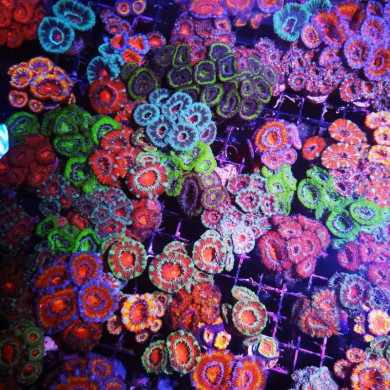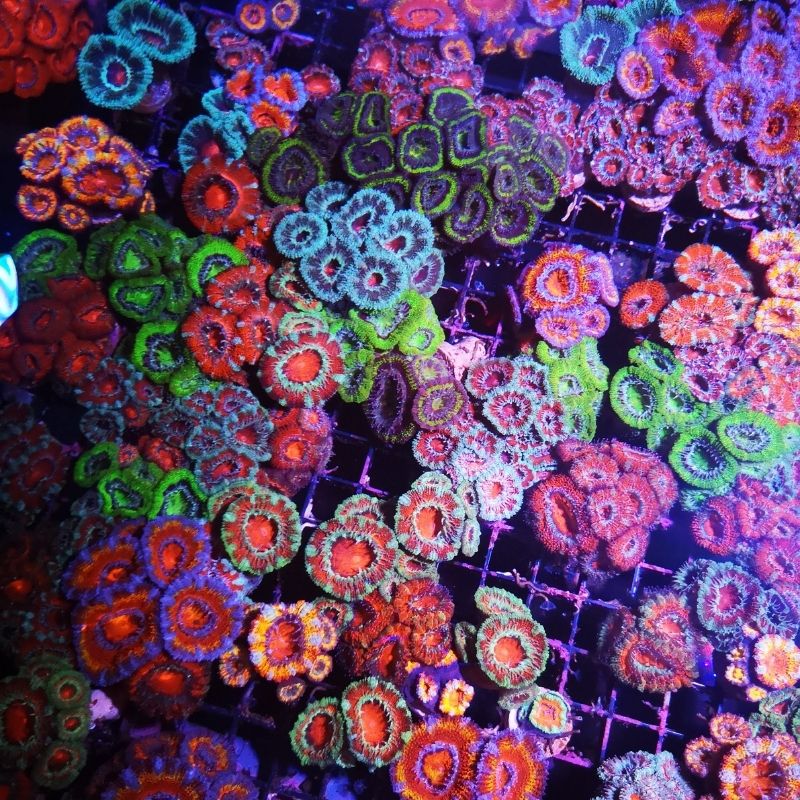Adding corals to a reef tank - when, how and where to place them?

Sometimes it is not easy to find the right position for each individual coral in the aquarium. We explain what you have to keep in mind and give tips on the right placement.
The time has come: Your tank is ready and you have already browsed through shops and spotted some corals that you like to buy. But is your tank ready yet? Which coral should be placed in which position? How close together may they be placed? We will answer these and other questions in the following article.
When can I introduce the first corals?
Quite simple: straight away. Provided that the salt concentration and temperature in your aquarium are correct, you can start stocking corals immediately. You may have to wait until the substrate has settled and the water is clear. But especially if you are using artificial live rock, there is no reason to wait longer than necessary - after all, what will happen if no biology is brought into the tank?
The only problem is that you should decide whether to introduce a complete stock (disadvantage: high investment costs) or to limit yourself to very low-maintenance corals and stock them gradually (disadvantage: limited choice of corals in the beginning). In any case, it is important to check the alkalinity and nutrient values regularly in this first phase and adjust them if necessary (avoid limitations). You will find more on the topic of starting a tank in a separate blog post.
How do I mount corals on the reef setup?
You can easily attach corals to your reef structure with glue. There are different types of glue on the market, e.g. cyanoacrylate gel (recommended for frags) or 2-component glue and reef cement (recommended for large coral colonies). Many corals come on so-called frag plugs. The frag plugs are handy for coral breeding and shipping, but sometimes they can be quite disturbing (and not nice to look at) in the reef aquarium. To avoid this, you can remove the pin of the frag plug with a pair of pliers or a side cutter and glue only the flat stone. In time, the coral will overgrow everything and integrate perfectly into the reef.
Where do I place the corals?
In addition to the species-specific requirements of each individual coral, other aspects are also crucial when positioning them in the reef tank. Below are our tips for you:
#1 Corals for the high light zone
The central, upper area of your reef setup should be reserved for the sun lovers among the corals. Acropora, Stylophora & Co are typical candidates for this zone. When choosing a location, take into account that even after these corals have grown vigorously, sufficient light can still reach the zones below.
.jpg)
Stylophora pistillata belongs to the corals that can be placed further to the top of the reef.
#2 Corals for the low light zone
On the other hand, there are corals that are predestined for the bottom area. Among them are such well-known representatives as Discosoma, Chalice or Cyphastrea. Bear in mind that these corals also need light - so they should not be placed in completely shaded areas.
#3 Corals and flow - who likes it turbulent?
Although no coral particularly likes to be placed directly in front of a powerhead, there are certainly species that prefer a strong water flow in their environment. Typically, these are corals that are found in nature on the reef top. Acropora, Stylophora, Montipora, but also soft corals and gorgonians are among them. Mushrooms and some LPS such as Blastomussa, Plerogyra, Fungia and Caulastrea, on the other hand, prefer less flow.
.jpg)
Soft corals such as Sarcophyton feel particularly comfortable in well-circulated locations.
#4 Coral islands - perfect places for potentially invasive corals
There are corals that can multiply relatively quickly. We recommend that you place such corals on "coral islands" - e.g. a separate stone that is somewhat removed from the main reef structure. This will prevent uncontrolled spreading. Potentially invasive corals include Xenia, Briareum and various Zoanthids.
#5 Beware of sweeper tentacles - these corals need space
Certainly you have heard the term "sweeper tentacles" in the context with corals. These special polyps are important to compete against nearby corals in the reef. Corals use them to nettle their neighbours in order to create space for themselves to grow. But you don't necessarily want such a fight in your aquarium. After all, peace and harmony should dominate in your home.
Corals that need a large safety distance include Galaxea, Echinopora, Euphyllia, Platygyra and Goniopora. Ideally, you should place these corals in such a way that the flow allows the tentacles to extend into the open water. There are also corals that do not form long tentacles but have an incredibly strong nettling power, such as Hydnophora and Acanthastrea echinata. They should definitely be placed in such a way that no other coral can fall into them (e.g. because they unfortunately detach themselves from the glue).
#6 Encrusting corals - perfect for the back wall or vertical areas in the reefscape
Some corals adapt their growth form to the prevailing environmental conditions (light and current). But there are also corals that grow exclusively flat. These corals are particularly suitable for the back wall or bare-bottom tanks (= aquariums without a substrate). Typical encrusting corals are found in large numbers among the Cyphastrea, Favia, Leptastrea and Montipora.
.jpg)
Cyphastrea - a beautiful encrusting coral that also copes well with low light.
#7 Corals for sandy bottoms
Sand, detritus and suspended sediment can be stressful for many corals. Especially with corals that form calyxes (Turbinaria, Echinopora, some Montipora), make sure that no sediment can collect in them, as this will lead to the death of the underlying tissue in the long term.
The "fleshy" LPS corals such as Scolymia, Trachyphyllia, Duncansopsammia and Caulastrea do well on a sandy substrate. Goniopora even like it when some detritus is stirred up every now and then so they can catch something nutritious from it.
#8 Coral gardens - side by side
If you have the opportunity, be sure to plan a coral garden in your reef. Here, corals can stand close together without becoming nettled. However, this only works with closely related species. For example, you can place Euphyllia paraancora, E. paradivisa and E. ancora very close together. Also different color morphs of Micromussa lordhowensis make a great display next to each other without getting nettled by each other. The same applies to Zoanthus and various soft corals.

Micromussa lordhowensis tightly packed together. Different color morphs of the same or closely related species can sometimes be placed directly next to each other without becoming nettled.
#9 The overall look - consider the combination of colors
Another not entirely unimportant aspect is the impression the coral placement has on you personally. For a harmonious overall picture, position the corals in such a way that a color mix is possible and you don't just collect green corals in one spot, for example. By the way, it looks very natural if corals of the same species and color appear several times in the reef. Also consider the growth form, for example, plating corals look particularly good in the side areas of the reefscape, where they can form large, beautifully curved plates without shading other corals underneath. Keep in mind, however, to leave enough space to the glass - otherwise cleaning will become difficult at some point.
#10 Last but not least: corals that need a lot of attention
Yes, they do exist. Corals that require special care. One of them is the beautiful Tubastrea, which opens its polyps mainly at night and should be fed regularly. Place such corals at locations in the reef that you (or your feeding pipette) can still easily reach.
These were our most important tips for coral placement in a reef aquarium. In our shop you will find information on flow and lighting preferences for each animal. If you have any further questions, please contact us at any time. Otherwise, we wish you lots of fun designing your coral reef!